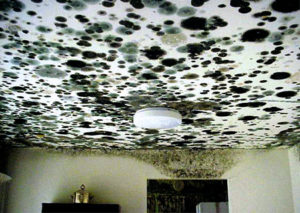Tips On Recognizing & Preventing Mold

Plumbing leaks, storm flooding, and an aging home can lead to the prime environment where mold loves to grow. Mold can grow anywhere, both inside and outside your home. When there are humid conditions, slab leaks, or roof leaks, mold spores can reproduce to an unhealthy level.
The best way to prevent mold is to ensure that your home is not leaking in any way. If there is any type of leak or excessive moisture in your home, drying is the best way to prevent mold. Unfortunately, not all leaks are readily visible. Here is some information from our Orlando leak detection specialists about how to detect leaks in order to avoid mold.
Slab Leak Detection
There are some obvious signs that will warn you when your concrete foundation is leaking. But there are also some that aren’t so obvious to the untrained eye. In many cases, a homeowner doesn’t even realize that they have a slab leak until it’s been going on for some time.
If you determine that the foundation of your home has a problem, give our experts a call and we will schedule an appointment to inspect the foundation for leaks.
Most often, leaks under the home are not easy to detect simply because they are under the home and are not always visible. The concrete will not only get wet and moist but can deteriorate or cause issues such as mold or mildew if the leak is not properly fixed. The concrete itself may also possibly need some repair where the plumbing leak is located.
Some of the more obvious signs you have a leak under or on your slab are:
- Rising water bill with no cause associated
- Sounds of running or gurgling water
- Movement on the water meter even though water faucets are off
- Warm spots on the concrete floor
- Wet floors
- Wet ground outside near the foundation
- Cracks in walls or floors
- Mildew or wet looking stains under your carpets or other flooring materials
If you’ve seen any of these signs, it’s important to call a professional Orlando slab leak detection service today. Damage to your slab foundation will only get more costly as the issue gets worse over time. Once mildew sets in, it’s difficult to get rid of it when it’s in a location such as flooring or foundations.
Signs Of Mold Growth
Another sure way to tell that you have a leak in your home is the growth of mold. It thrives in moist areas out of the sunlight. This means that it can grow within the wall and floor cavities of your home or in any dark place with the right conditions for it to reproduce.
Mold and decay are caused by fungi, a microscopic organism. There are different species of fungi, some of them being hazardous to our health when they are thriving. For some, wood offers the required food supply for them to reproduce. Some grow on other building materials that contain limestone. An example of the latter is the dark roof stains you often see on asphalt shingles.
Mold damage causes decay no matter what it is growing on, so it’s a good idea to inspect for mold. Mold stains occur in various concentrations and sizes depending on the pattern of the superficial growth. When favorable conditions are present, such as near leaking plumbing, the mold will become established and develop into large patches.
Look for discoloration on the building materials of your home. The mold will likely be a noticeable fuzzy or powdery surface growth. Colors can range from light shades to black or brighter colors like green and yellow.
Water soaked building materials are not likely to have mold growth because they are too saturated for the air to get to the surface where the fungi would grow. The likely area is near the area where it’s just moist.
Moldy wood will be stained and will often feel spongy when the problem has gone on long enough. Be sure you check around the roof line and thoroughly examine all outbuildings made of wood. For more information, please call Above & Beyond Leak Detection, Inc..
If you need information about Leak Detection Service in Orlando, please call Above & Beyond Leak Detection, Inc. at 407-692-5868 or complete our online request form.
More Tips on Preventing Mold












